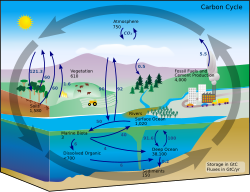Kolsänka

En kolsänka eller en CO2-sänka är en växande kolreservoar och är motsatsen till en kolkälla. De huvudsakliga kolsänkorna är världshaven och växande vegetation. Båda urlakar kol från atmosfären genom att biomassan använder kol vid sin uppbyggnad såsom plankton och träd. Uttrycket har blivit känt mest beroende på Kyoto-protokollet.[1][2][3][4]
Olika sätt att öka upptagningen av kol från atmosfären diskuteras i dag på grund av växthuseffekten som förstärks av ökande halt av CO2. Det finns både idéer om att artificiellt lagra koldioxiden och att öka skogarnas och världshavens upptagning av koldioxid.
Se även
Referenser
Noter
- ^ Balal Yousaf, Guijian Liu, Ruwei Wang, Qumber Abbas, Muhammad Imtiaz, Ruijia Liu: Investigating the biochar effects on C-mineralization and sequestration of carbon in soil compared with conventional amendments using stable isotope (δ13C) approach. GCB Bioenergy 2016; doi:10.1111/gcbb.12401
- ^ Karen Palmer. ”Electricity, Renewables, and Climate Change: Searching for a Cost-Effective Policy” (PDF). Resources for the Future. Arkiverad från originalet den 4 juni 2007. https://web.archive.org/web/20070604191032/http://www.rff.org/Documents/RFF-RPT-Renewables.pdf. Läst 6 augusti 2018.
- ^ Manguiat, M. S. Z., Verheyen, R., Mackensen, J. & Scholz, G. (2005). ”Legal aspects in the implementation of CDM forestry projects” (pdf). IUCN Environmental Policy and Law Papers. Number 59. Arkiverad från originalet den 16 juli 2010. https://web.archive.org/web/20100716142612/http://data.iucn.org/dbtw-wpd/edocs/EPLP-059.pdf. Läst 6 augusti 2018.
- ^ Rosenbaum, K. L., Schoene, D. & Mekouar, A. (2004). ”Climate change and the forest sector. Possible national and subnational legislation”. FAO Forestry Papers. Number 144. http://www.fao.org/docrep/007/y5647e/y5647e00.HTM.
Externa länkar
Media som används på denna webbplats
This carbon cycle diagram shows the storage and annual exchange of carbon between the atmosphere, hydrosphere and geosphere in gigatons - or billions of tons - of Carbon (GtC). Burning fossil fuels by people adds about 5.5 GtC of carbon per year into the atmosphere.
